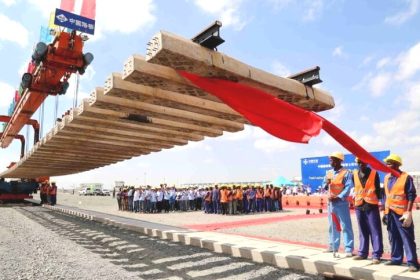Ugandan economy shows signs of recovery
January 11—Uganda’s economy slowed in the first quarter of financial year 2017/18 compared to the last quarter of 2016/17, but overall growth remains far better during this current financial year than the previous one. The first quarter runs from July to September.

There was a decline in transport activities partly due to a decline in the operations of Rift Valley Railways.
According to figures from the Uganda Bureau of Statistics (UBOS), the real Gross Domestic Product (GDP) for Q1 of 2017/18 grew by 1.3 percent compared to 2.5 percent in the Q4 of 2016/17.
However, year-on-year quarterly GDP growth stood at 7.5 percent in Q1 of 2017/18 compared to the growth of 2.1 percent in Q1 of 2016/17. In value terms, the economy expanded from UGX 15,148 billion (about $4 billion) in Q1 2016/17 to UGX 16,290 billion (about $4.3 billion in Q1 2017/18.
During FY2016/17 Uganda’s economy slowed down to less than 4 percent which was half of the average growth rates seen during much of the 1990s.
Like several other countries around the world, 2016 was also a bad year for Uganda as an extended dry spell hit agriculture and commodity prices on the international market dropped sharply.
However towards the end of 2017 and reflected in successive Stanbic PMI scores showing a positive outlook (above 50) in the private sector, the economy has been slowly shrugging off the 2016 effects characterized by the former dampened consumer confidence.
Ben Mungyereza, UBOS executive director said, “The increase in value added in financial and insurance activities was largely from increased activity for commercial banks. On the other hand, there was a decline in trade activities by 1.0 percent due to a decline in import volumes. There was also a decline in transport activities by 0.7 percent partly due to a decline in the operations of Rift Valley Railways.”
In terms of economic sectors, value added in agriculture grew by 9 percent, compared to a decline of 2 percent in Q1 2016/17. This was mainly due to an increase in food crop growing activities that went up by 11 percent. Services recorded a 8.7 percent rise in value-added, compared to 3.7 percent in Q1 2016/17.
Industry activities value added grew by 5 percent in Q1 2017/18, a slight improvement from 4.2 percent seen during Q1 2016/17. The main drivers of this growth were manufacturing and construction activities which grew by 3.7 percent and 5.6 percent respectively.
According to UBOS, quarterly Gross Domestic Product (QGDP) at constant 2009/10 prices estimates for Q1 of 2017/18 grew from UGX14,974 billion registered in Q4 of 2016/17 to UGX15,168 billion.
Value added in the agriculture sector in Q1 of 2017/18 grew from 3,248 billion shillings in Q4 2016/17 to 3,256 billion. This was mainly due to an increase in food crop growing. The growth in value added for food crop growing activities was due to improved yields for maize and bananas. On the other hand cash crops growing activities declined by 4.1 percent in Q1 of 2017/18 due to a decline in coffee and tea production.
Industry activities value added grew in Q1 2017/18 from UGX2,724 billion in Q4 2016/17 to UGX 2,805 billion shillings. The main drivers of this growth were manufacturing activities. This was mainly due to an increase in beer and soft drinks production.
The services sector value added grew from UGX7,807 billion shillings in Q4 2016/17 to UGX7,926 billion in Q1 2017/18. The main drivers to this growth were information and communication (2.9 percent), financial and insurance (2.6 percent), public administration (1.4 percent), education (3.3 percent) and health (0.5 percent) activities.

 AfDB puts up nearly $700m for Burundi-Tanzania SGR link
AfDB puts up nearly $700m for Burundi-Tanzania SGR link
 Bank of Uganda keeps base rate at 9.5% to support surge in GDP growth
Bank of Uganda keeps base rate at 9.5% to support surge in GDP growth
 Africans must resist being bulldozed in energy transition timetable debate
Africans must resist being bulldozed in energy transition timetable debate
 Standard Bank Group appoints new Chief Executive for Uganda Holdings
Standard Bank Group appoints new Chief Executive for Uganda Holdings
 TradeMark Africa introduces new App to limit EAC trade barriers
TradeMark Africa introduces new App to limit EAC trade barriers
 Employer hiring up during November as Stanbic PMI rises to 53.4
Employer hiring up during November as Stanbic PMI rises to 53.4
